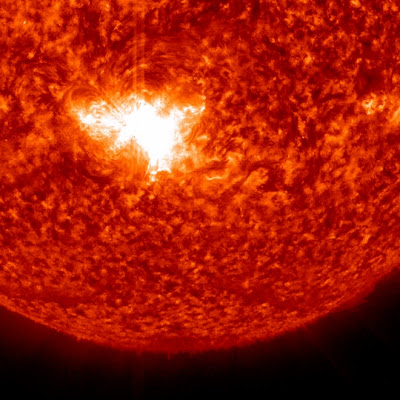Disaster Report: A powerful solar flare (sun storm) that occurred on July 2 is said to reach the Earth today (July 4) according to NASA.
Want To Share!! Let Others Know
Report through contact form or write in comment section below
Disaster Report @ facebook (Natural Disasters list), twitter (Disaster_Update) and Google +(Disaster Report)
Keep This Page Open Or Visit Later To Get Update Report
Check Worldwide Natural Disasters List + Detail Report
Related Posts:
-A powerful solar flare (sun storm) that occurred on July 2 is said to reach the Earth today (July 4).
-M 5.6 class solar flare erupted in the Sun’s southern hemisphere two days ago from large Sunspot 1515.
-This solar flare is registered as a class M 5.6 solar storm based on the scale used by astronomers to measure the sun's weather.
-Limited blackout of HF (high frequency) radio communication for tens of minutes could be observed in the sub-solar point on the sunlit side of Earth.
-On July 5, NASA will launch a mission called the Solar Ultraviolet Magnetograph Investigation or SUMI, to study the intricate, constantly changing magnetic fields on the sun in a hard-to-observe area of the sun's low atmosphere called the chromosphere.
About Solar flare
Solar flares are tremendous explosions on the surface of the Sun which releases energy of up to 6 × 1025 joules. Solar flares release energy in many forms – high intensity electro-magnetic radiation (Gamma rays, X-rays, UV), energetic particles (protons and electrons), and mass flows.
Solar flares are classified as A, B, C, M or X according to the peak flux (in watts per square meter, W/m2) with each classification being ten times stronger than the previous one.
A- < 10−7
B- 10−7 - 10−6
C- 10−6 - 10−5
M- 10−5 - 10−4
X- > 10−4
Hazards/Effects
Most solar flares are harmless, but occasionally they can cause big problems. Solar flares influence the local space weather in the vicinity of the Earth. X-class solar flares can endanger spacecraft and astronauts in orbit, interfere with satellite signals, as well as damage power lines and other infrastructure on the ground.
Solar flare facts
*Richard Carrington observed a flare for the first time on 1 September 1859.
*Solar storm of 1859 is believed to be the biggest solar flare ever recorded in history.
Below you can watch wonderful video on Solar flare by NASA.
Follow Disaster Report @ facebook (Natural Disasters List), twitter (Disaster_Update) and Google +(Disaster Report)
Want To Share!! Let Others Know
Report through contact form or write in comment section below
Disaster Report @ facebook (Natural Disasters list), twitter (Disaster_Update) and Google +(Disaster Report)
Keep This Page Open Or Visit Later To Get Update Report
Check Worldwide Natural Disasters List + Detail Report
Related Posts:
-A powerful solar flare (sun storm) that occurred on July 2 is said to reach the Earth today (July 4).
-M 5.6 class solar flare erupted in the Sun’s southern hemisphere two days ago from large Sunspot 1515.
-This solar flare is registered as a class M 5.6 solar storm based on the scale used by astronomers to measure the sun's weather.
-Limited blackout of HF (high frequency) radio communication for tens of minutes could be observed in the sub-solar point on the sunlit side of Earth.
-On July 5, NASA will launch a mission called the Solar Ultraviolet Magnetograph Investigation or SUMI, to study the intricate, constantly changing magnetic fields on the sun in a hard-to-observe area of the sun's low atmosphere called the chromosphere.
About Solar flare
Solar flares are tremendous explosions on the surface of the Sun which releases energy of up to 6 × 1025 joules. Solar flares release energy in many forms – high intensity electro-magnetic radiation (Gamma rays, X-rays, UV), energetic particles (protons and electrons), and mass flows.
Solar flares are classified as A, B, C, M or X according to the peak flux (in watts per square meter, W/m2) with each classification being ten times stronger than the previous one.
A- < 10−7
B- 10−7 - 10−6
C- 10−6 - 10−5
M- 10−5 - 10−4
X- > 10−4
Hazards/Effects
Most solar flares are harmless, but occasionally they can cause big problems. Solar flares influence the local space weather in the vicinity of the Earth. X-class solar flares can endanger spacecraft and astronauts in orbit, interfere with satellite signals, as well as damage power lines and other infrastructure on the ground.
Solar flare facts
*Richard Carrington observed a flare for the first time on 1 September 1859.
*Solar storm of 1859 is believed to be the biggest solar flare ever recorded in history.
Below you can watch wonderful video on Solar flare by NASA.
Follow Disaster Report @ facebook (Natural Disasters List), twitter (Disaster_Update) and Google +(Disaster Report)
